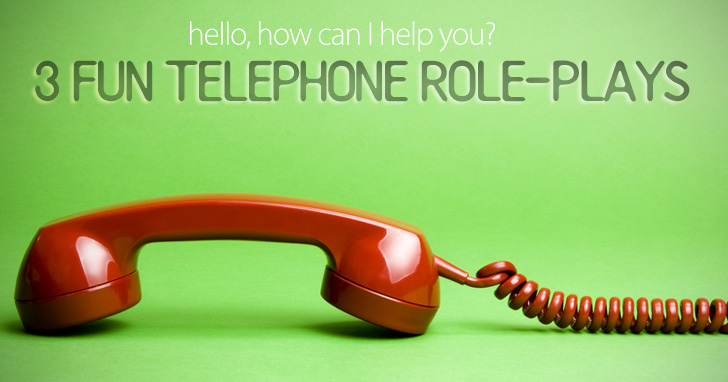Hello, How Can I Help You? 3 Fun Telephone Role-plays


Here are thirteen in-class discussion starters just right for two students at a time.

We can always learn more about the people around us, no matter how long we have known them. Give your student pairs time to interview each other, either on a specific topic or just in general, and then let them share any interesting facts they discovered with the rest of the class at the end of the discussion period.
Controversial topics are great for getting students talking whether it’s with the entire class or one on one. People like to discuss their own opinions. And with a class of internationals and people from different countries around the world, you will have differences of opinion among your students. Remind your students to listen to their partners and respect opposing opinions, give your students a topic, and let the discussions happen.
Role plays are a great go to in conversation class. If you like, write several jobs or celebrities on Popsicle sticks and put them in a cup. Then give your students a situation in which they will be interacting – at the post office, ordering a meal, etc. Have one or both people choose a stick for their identity and let them go from there.
At times, scripted dialogues can be used effectively in class. Give one to pairs in your speaking class and let them learn from the model before attempting a similar conversation on their own.
Called either a jigsaw or information gap activity, giving each student only part of the information in a conversation is a great way to get them talking. Each person will need the information the other one possesses to either answer questions on a certain topic, negotiate a solution, or solve a problem that they are given.
This technique will work in combination with almost any other, but keep in mind that speed conversations are fast. If you know anything about speed dating, you have a good idea how this works. Have your class arrange their chairs in two lines so each person is sitting across from another. Give your students two minutes to talk on the subject you assign or complete the task you give; then call time. Now one line of students will move one seat to their right and face a new partner. These two will talk for the next two minutes at which point the same line of students will move one seat to the right again. Keep going until each person in the moving line ends up back in the seat in which they started.
You can find a nearly limitless selection of these types of activities online, so keep a bunch handy for speaking class. Assign one activity to everyone in your class at the same time, or have each pair of students choose one ice breaker from instruction slips in a hat. Do as many activities as you have time for, and feel free to change partners between each activity.
Games are always a fun addition to class, and there are plenty designed for just two players. They can be simple, no-prep games like hangman, or they can be more formal games like Scrabble. Whatever the case, encourage your students to spend lots of time talking as they play.
This fun drawing activity can be used to practice a variety of vocabulary and grammar constructions. Have two students sit back to back, each with a blank piece of paper. One person draws a picture on their paper and describes what they are drawing to their partner who then has to draw the same thing on their paper. After the pictures are complete, students compare their drawings to see how similar they are and how well the one gave instructions to his partner. Have students switch roles and try the activity again.
The more practice you give your students with simulated telephone conversations, the better they will do when they encounter the real thing. You can give your students a scenario to play out for a phone conversation or give them a goal to accomplish. Or you can just let them talk about whatever relates to what you are teaching that day. Just be sure your students sit back to back as they talk. This way they will be devoid of the visual clues that we have in face to face conversations but don’t have in telephone conversations.
You can use flashcards for lots of different activities in class including vocabulary review, matching games, and conversation starters. If you have flashcards in class, let your students use them with a partner, and give them a few options for activities: memory game, go fish, describing a picture and having their partner guess, etc.
If you have creative students in speaking class, let them write a story or a skit together. They will need to talk to each other to decide what will happen, and then they can work together to get the story written down. Have them share their story with the rest of the class when they have completed it, or invite them to illustrate their stories and then display them on a bulletin board.
Pictures can be used in several ways for a one on one discussion. You can have one person describe a picture that you give them and have their partner draw from the description they are given. Make sure neither student can see the other’s paper. You can also give students two different but similar pictures and ask them to discuss the differences and the similarities. Worth1000.com is a good source for pictures for this activity.